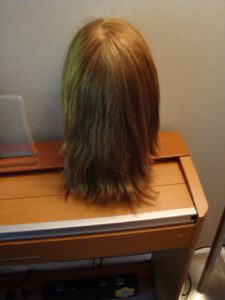In late breaking (Tuesday) news, Mazel Tov to our friends Gerald and Mindy Gartner upon the arrival of yet another grandson (Keyn Yirbu), born to their children Batya and Michael Schafer. Mazel tov tov to all uncles, aunts, first cousins and to both extended families. Bris information to follow pending color checks; stay tuned.
The First Sheytil (Wig):
Who decided and when, that orthodox married women must don sheytils (wig) to cover their hair? Believe it or not, the answer may be found in this week’s parsha. We will certainly address that; halt zich eyn!
Oisvorfer followers avada know that we love quoting the medrish because as we have stated over and again, medrish adds beautiful color to text and allows our imaginations to visualize beyond the words. We love medrish and specifically medrish aggadah (not law) as found in the heylige Gemora, because it fills gaping holes in the text and provides rabbis, speakers, writers, and others in need of something to say at a wedding, bar mitzvah, other simchas, and even at the Shabbis tish, with rich materials. Never mind that many of them are efsher apocryphal, or allegorical. Still they are avada nice to read. There is abundant medrish on kimat any topic one can imagine. Speaking imaginations running wild, we will soon explore one of the Oisvorfer’s favorite of all medroshim, this one found in the heylige Gemora and elsewhere. It’s particularly popular in June, a month that features more weddings than most, and it’s one that is oft repeated at a sheva brochis.
 This past Sunday, with July 4th looming, the Oisvorfer was seriously considering posting a repeat of Koirach, one he penned back in 2013. It was taka a gem and can be found here. Ober, following a discussion with a chaver (who went through the yeshiva system) during which this particular medrish was discussed, and after he stated his belief in this and all other medrish to be 100% emes, the Oisvorfer had a change of heart and decided to start all over again with a few new thoughts for 2016. Nu, zug shoin (tell me already), what does the heylige Gemora tell us? We’ll get to it very soon. Let’s begin however with a comment received this past week in response to last week’s givaldige piece on Kolave, Yihoishua and whether or not, bad people can influence good ones, or farkert. We were also puzzled why so few name their kids Kolave, a true Toirah hero, one the RBSO shouted out for special attention with great admiration.
This past Sunday, with July 4th looming, the Oisvorfer was seriously considering posting a repeat of Koirach, one he penned back in 2013. It was taka a gem and can be found here. Ober, following a discussion with a chaver (who went through the yeshiva system) during which this particular medrish was discussed, and after he stated his belief in this and all other medrish to be 100% emes, the Oisvorfer had a change of heart and decided to start all over again with a few new thoughts for 2016. Nu, zug shoin (tell me already), what does the heylige Gemora tell us? We’ll get to it very soon. Let’s begin however with a comment received this past week in response to last week’s givaldige piece on Kolave, Yihoishua and whether or not, bad people can influence good ones, or farkert. We were also puzzled why so few name their kids Kolave, a true Toirah hero, one the RBSO shouted out for special attention with great admiration.
Dear Oisvorfer Ruv
For over three years, a good friend has been forwarding your weekly devar Torah’s which I read religiously. It’s one of the few religious things I still do with kavono. Had you been my rabbi in my formative years, I might be more observant. Late every Thursday night like clockwork, it’s in my inbox. I have never commented before today. This week, after reading your take on Kolave and your other insights which are quite remarkable, I wanted to urgently reach you and tell you a few things. Your original thoughts are amazing. Your humor is crisp. You are a very funny man and an excellent teacher. A few might find you cynical, not me. Personally, I think your belief in God is quite strong. Last week, I clicked as you suggested and went back to your archives on the parsha. I read every all your Shelach posts and they were truly amazing. You have a way of making the Torah so interesting and easy to digest. Weekly, you raise questions that were never asked or properly answered. Yes, you inject many Yiddish words that are foreign to me, humor which is not, and many sexually laced comments. I love them all and you have taught me quite a bit. My friends and I regularly text each other with a few of your funnier lines and discuss your writings each shabbos. We were wondering if you might consider a weekly podcast of the parsha and think it’s a good idea. And if blessed with another boy, I will certainly consider Kolave for his name.
Keep it up please
Brian Bidner
Nu Brian, the Oisvorfer is avada very touched by your comment, as he was by a few of his rebbes in yeshiva. So happens that every word you wrote is emes! Thankfully, your comment did not include an invoice! Keep on enjoying the weekly parsha reviews. As to the podcast, it’s taka an idea worthy of further exploration and will be discussed with the Oisvorfer’s talent manager, agent, and webmaster. Efsher one day soon.
A gittin choidesh-
Shoin, where were we?
How many times has the Oisvorfer told you that the heylige Toirah which contains Taryag mitzvis (613 commandments), has over the generations, inspired many new entrepreneurs who were clever enough to read the lines, and between the lines? Many! Those who delved into the heylige Toirah and read carefully through each and every mitzvah, chapped that proper observance can be rewarding, very. We speak not of a spiritual uplifting; we speak instead davka to the heylige Toirah being a guidebook to making a living. At times, a damn good one. A healthy number of those who chapped this concept have, over the years, decades and generations, become multimillionaires, mamish. That’s efsher pshat in what our sages taught us: the RBSO gave us His heylige Toirah as a gift. A gift that keeps on giving. And taka we should be thankful. So happens that this week’s parsha gave birth to one of the largest of all non-food related business opportunities ever.
 We speak about the requirement for a married woman to keep her hair covered. Ober where in the heylige Toirah does it tell us that married women must cover their hair? Grada, it doesn’t! Ober what it did tell us a few weeks back, (parshas Nosi) where we learned all about the Soitah -she, the married woman suspected (for good reason) of having illicit sexual relations with another man- was azoy. As part of the Soitah ceremony, the koihen (Priest) who drew the lucky card (yes, it was a lottery system) to be the administrator of the Soitah Water drink (not a terrible brand name), was also charged, prior to administering the potentially fatal concoction, with uncovering the woman’s hair. He also tore open the top part of her dress; that for another day. And vus meynt duz (what does that mean)? Just before she drank the magic potion, if her hair was up, efsher in a pony tail, braided, or otherwise styled, his job was to unbraid, let it out or down, so that it flowed freely. Why? Ver veyst. Seemingly the exercise was meant to cause the woman some additional embarrassment and to let her know that even if innocent of the adultery charges, she was still somehow exposed (as maybe she was when having her dalliance with her lover).
We speak about the requirement for a married woman to keep her hair covered. Ober where in the heylige Toirah does it tell us that married women must cover their hair? Grada, it doesn’t! Ober what it did tell us a few weeks back, (parshas Nosi) where we learned all about the Soitah -she, the married woman suspected (for good reason) of having illicit sexual relations with another man- was azoy. As part of the Soitah ceremony, the koihen (Priest) who drew the lucky card (yes, it was a lottery system) to be the administrator of the Soitah Water drink (not a terrible brand name), was also charged, prior to administering the potentially fatal concoction, with uncovering the woman’s hair. He also tore open the top part of her dress; that for another day. And vus meynt duz (what does that mean)? Just before she drank the magic potion, if her hair was up, efsher in a pony tail, braided, or otherwise styled, his job was to unbraid, let it out or down, so that it flowed freely. Why? Ver veyst. Seemingly the exercise was meant to cause the woman some additional embarrassment and to let her know that even if innocent of the adultery charges, she was still somehow exposed (as maybe she was when having her dalliance with her lover).
Ober, what has all this to do with parshas Koirach, this week’s parsha? Nu, from the Soitah, our good rabbis in the heylige Gemora taught us that a married woman’s hair is considered erva (sensual and potentially sexually erotic and stimulating) and must be kept covered lest other men gaze upon her and become unduly excited. Such excitement could efsher lead to mixed dancing or worse. What could be worse? Shoin! And from that procedure as described in great detail and color in the text of the heylige Toirah, our rabbis concluded that it was biblically mandated for a married woman’s hair to be covered. Only her husband could see it. Does everyone agree? Of course not! Others argue that hair covering is mandated but is rabbinic (only) in nature. Shoin, we needn’t debate that issue here and now.
 Nu, it took a few generations ober one day, a nice Jewish fellow, efsher inspired by Marie Antoinette or others, and decided that the best way to cover sexy female hair, was with a sheytil, a wig. Avada there were arguments among many a rabbi as to whether or not the sheytil was effective in curbing man’s desires, and for a number of decades or longer, there were rabbis who ruled that the sheytel could not be worn to cover the erva because it wasn’t getting the job done. Farkert: Men gazing at married women donning a sheytil were just as excited as they were without. Efsher more so. Ober, eventually, the sheytil was universally accepted (by most) and today, the sheytil business is ginormous. We needn’t explore just how large, ober kulo almi loi piligi (few if any would argue) that it’s big business. Family fights have erupted over the payment of the sheytil, shiduchim (matches) have been held up and broken until the parties agreed on which side pays for the sheytil or in today’s modern times, a few of them.
Nu, it took a few generations ober one day, a nice Jewish fellow, efsher inspired by Marie Antoinette or others, and decided that the best way to cover sexy female hair, was with a sheytil, a wig. Avada there were arguments among many a rabbi as to whether or not the sheytil was effective in curbing man’s desires, and for a number of decades or longer, there were rabbis who ruled that the sheytel could not be worn to cover the erva because it wasn’t getting the job done. Farkert: Men gazing at married women donning a sheytil were just as excited as they were without. Efsher more so. Ober, eventually, the sheytil was universally accepted (by most) and today, the sheytil business is ginormous. We needn’t explore just how large, ober kulo almi loi piligi (few if any would argue) that it’s big business. Family fights have erupted over the payment of the sheytil, shiduchim (matches) have been held up and broken until the parties agreed on which side pays for the sheytil or in today’s modern times, a few of them.
Ober we ask the zelba kasha (same question): what has all this to do with parshas Koirach which recounts the amazing story of a fellow named Koirach, his band of co-conspirators, and protagonists who were active participants in an attempted mutiny against Moishe’s leadership? Nu, to chap all this, we need to look at the very first posik of the parsha (Bamidbar 16:1) which tells us azoy:
| 1. Korah the son of Izhar, the son of Kohath, the son of Levi took [himself to one side] along with Dathan and Abiram, the sons of Eliab, and On the son of Peleth, descendants of Reuben. | אוַיִּקַּח קֹרַח בֶּן יִצְהָר בֶּן קְהָת בֶּן לֵוִי וְדָתָן וַאֲבִירָם בְּנֵי אֱלִיאָב וְאוֹן בֶּן פֶּלֶת בְּנֵי רְאוּבֵן: |
With this verse, we are introduced to the cast. Koirach, Doson & Aviram (last seen fighting in parshas Shemois), and a fellow named Oin ben Peles. They are the leaders. The heylige Toirah dedicates a full 35 of 95 pisukim to this ugly chapter in our (otherwise) glorious history and in the end, Koirach, his beloved wife, Doson, Avirom, their families, another 250 and an additional 14,750 will all be dead. Revolution over and kaput. New readers and those unfamiliar with the story should avada click into archives here and check out Koirach 2010-2015 for more gems.
Ober one fellow has gone missing from the script. Whatever happened to Oin ben Peles? He was shouted out in the very first verse but is never again mentioned in the heylige Toirah. Grada, it’s quite unusual for a named individual, good or bad, to have but one appearance (Oin might be the only one), ober the fact is that we are left hanging about Oin. Where did he go and what happened to him?
 As it turns out, many were bothered by the same question. And the heylige Gemora (Sanhedrin 109b-110A) recognized this lacuna in the text and did what it does best; it filled in the missing pieces of the story. What a story it is, amazing mamish. Lommer lernin. Says the heylige Gemora azoy: Oin was married to Mrs. Oin ben Peles. Seemingly, the Gemora forgot to give her a name. When she heard Oin’s plans to join the revolution against Moishe, she talked him down. How? She told him that he did not have a dog in the fight; either way he was a loser.
As it turns out, many were bothered by the same question. And the heylige Gemora (Sanhedrin 109b-110A) recognized this lacuna in the text and did what it does best; it filled in the missing pieces of the story. What a story it is, amazing mamish. Lommer lernin. Says the heylige Gemora azoy: Oin was married to Mrs. Oin ben Peles. Seemingly, the Gemora forgot to give her a name. When she heard Oin’s plans to join the revolution against Moishe, she talked him down. How? She told him that he did not have a dog in the fight; either way he was a loser.
Whether Koirach prevailed or not, He, Oin, would gain nothing. She didn’t want him involved. What to do? Seemingly she recalled what other fine Toirah women did when they needed to take control. She recalled the daughters of Loit. She plied him with wine and soon thereafter, he fell into bed in a drunken stupor. Ober because she was already married to him, no sex followed. A tradition that continues ad hayoim hazeh, if you chap. In any event, with Oin fast asleep and knowing that Koirach or his co-horts were scheduled drop by to pick him up for the great confrontation, she placed herself near the opening of the tent. So far so good. What next? The Gemora continues: she uncovered her hair! OMG! And? When it was time to get Oin, those who came knocking, noticed that Mrs. Oin was exposed, her hair that is, and avada it was not tzniusdik (modest) to gaze upon a married woman’s uncovered hair. Shoin: they left without Oin. They went to their ultimate death and according to this Gemora, Oin was saved by a hair, or, in this case many, that belonged to his fast thinking wife. And that’s taka how this Gemora was taught to the Oisvorfer and many others. Ober in other yeshivas, they taught the myseh azoy: With Oin safe and sound in bed, Mrs. Oin taka let her hair down, ober it wasn’t her real hair. She simply removed her sheytil (wig)), thereby exposing her real hair, say it’s not so please. Veyst zich ois (apparently), Mrs. Oin was efsher the first person ever to don a sheytil to cover her ervadike (sensual) hair. Shoin.
Exactly why it took Toirah / Gemora inspired Yiddin so many generations to chap this myseh and then proclaim that every woman must cover her sexy hair with an even sexier sheytil, ver veyst? Ober es veyst zicvh ois, that all recorded dates for the first ever sheytil might be wrong. Ober the kasha remains: whatever happened to Oin and why taka did he disappear after a lone Toirah shout out? And the answer raboyseyee might be azoy.
Could it be that Oin’s sole role in the planned but failed mutiny was to give rabbis and speakers, for generation to come, a nice story about how a woman can save her husband from evil and danger? Was he specifically placed into a story which is read kimat every single year during the height of wedding season so that speakers might have something intelligent to say about the kallah and wish upon the new husband that his wife emulate the ways of Mrs. Oin who came to the rescue and saved her husband from certain doom? After all, none of this medrish is recorded or even hinted to in the heylige Toirah. Is this how the story possible went down? Ver veyst? Maybe it did, maybe it didn’t. In the end, it is shayich: we just need to imagine -as does the medrish- that Oin was taka placed into the Koirach story so that those getting married in June would have a sheva brochis devar Torah.
While Mrs. (no-name) Oin hatched a plan to save her husband by removing her wig and exposing her sexy hair, another hair raising discussion was taking place over at the Koirach household. The heylige Gemora also records a conversation between Koirach and his (also) unnamed wife during which she goads him further into the conspiracy by suggesting that Moishe made Koirach shave all his hair because, among other things, Moishe was jealous of Koirach’s hair. Though Koirach answered that Moishe too shaved his hair, his plans did not change. He was resolute, the mutiny was to move forward as planned. Moishe had to go and Mrs. Koirach was stoking his flames of jealousy. Many of you avada learned or heard this famous Gemora on Oin and his givaldige wife. Grada the story is also recorded in the medrish (Medrish Rabba 18:20 and can also be found in the Medrish Tanchuma).
Ober this year, and after more digging, the Oisvorfer for the very first time, came across a medrish (Toirah Sheleima) he had never before seen or known. It continues where the heylige Gemora lets off and tells us azoy: As described in the heylige Toirah, Moishe asked the RBSO to perform a miracle. He asked for the earth to open its mouth (think large sinkhole) and to swallow up the protagonists. This would be proof positive that Moishe was the real deal, the RBSO’s true messenger and not making up his own rules. As an aside, this was the very first and maybe only time Moishe asked the RBSO to punish someone and in an unnatural manner. Shoin, the RBSO did just that. When the earth opened its mouth (such mouth having been created, according to some, during the six days of creation, but waiting in limbo for that very moment), Oin was still fast asleep in his bed. You will recall that he had been plied with wine. The bed he occupied began to rock. Let’s recall he was in it alone, if you chap. It began rolling forward towards the now open mouth of the earth. The others had already been swallowed up.
 Ober Mrs. Oin, resolute as ever, chapped the bed and said azoy: “Oh Lord of the worlds, my husband made a solemn vow never again to partake in such dissentions. You who live and endure throughout eternity can punish him should he violate his vow.” The RBSO heard her plea -we can avada speculate that she put her sheytil back on while davening to the RBSO- and Oin, though never again mentioned anywhere in the heylige Toirah, was saved yet again by his eishes chayil of a wife. And taka, a posik (verse) oft-time quoted by rabbis and others, mostly when seeking to heap praise upon a woman, taken from Mishlei (Proverbs) states azoy: “Every wise woman builds her house, but the foolish woman pulls it down.” The wise woman avada referring to Mrs. Oin, a potentially fictional character introduced efsher to teach us a valuable lesson about a good woman saving her family and household, while the latter half of the quote seemingly refers to Mrs. Koirach, perhaps also introduced to teach men about the damage and destruction that a shrew of a wife can cause. Whether or not Mrs. Koirach wore a sheytil or not, we don’t know. We do know that she was terribly upset with how her husband looked without his hair. Perhaps he should have considered one. Is medrish givaldig or what?
Ober Mrs. Oin, resolute as ever, chapped the bed and said azoy: “Oh Lord of the worlds, my husband made a solemn vow never again to partake in such dissentions. You who live and endure throughout eternity can punish him should he violate his vow.” The RBSO heard her plea -we can avada speculate that she put her sheytil back on while davening to the RBSO- and Oin, though never again mentioned anywhere in the heylige Toirah, was saved yet again by his eishes chayil of a wife. And taka, a posik (verse) oft-time quoted by rabbis and others, mostly when seeking to heap praise upon a woman, taken from Mishlei (Proverbs) states azoy: “Every wise woman builds her house, but the foolish woman pulls it down.” The wise woman avada referring to Mrs. Oin, a potentially fictional character introduced efsher to teach us a valuable lesson about a good woman saving her family and household, while the latter half of the quote seemingly refers to Mrs. Koirach, perhaps also introduced to teach men about the damage and destruction that a shrew of a wife can cause. Whether or not Mrs. Koirach wore a sheytil or not, we don’t know. We do know that she was terribly upset with how her husband looked without his hair. Perhaps he should have considered one. Is medrish givaldig or what?
And we will close with this final thought on Koirach. We have, over the years, discussed Koirach at length and mentioned that he was known as the richest of all Yiddin. He was? Were his slave wages higher than most? Or, was he lucky enough to borrow more gold, silver and other valuables from his neighbors (as the Yiddin were instructed by the RBSO) as they and he left Mitzrayim? Or, was he lucky enough to grab more gold and other riches the Yam Suf spit out following the drowning of the pursuing mitzrim? Grada not: According to the medrish, Koirach, a grandson of Levi, was never enslaved. Ober if was unemployed and also not enslaved, how taka did he make money and how taka did he amass such enormous wealth that for generations to come, people including the Oisvorfer’s own parents – OBM, would bless their children to become “rych azoy vi Koirach” (we should become as wealthy as Koirach)? What business was he in over in Mitzrayim or in the desert that allowed him to become so fabulously wealthy? Avada we don’t know for sure so let’s see what the heylige Medrish and Gemora have to say. Says the Gemora (Sanhedrin) a mamish gishmake myseh (story) azoy: shortly after Yoisef became the viceroy of Egypt, the famine he predicted when analyzing Paroy’s dreams, came about. The mitzrim were hungry and ran to Yoisef for food. He had the keys and control of the granaries. Yoisef, thinking mamish like a good frum business man, raised the prices; shoin, it was all but a simple supply and demand issue. They paid. When they ran out of money, he made them exchange other valuables including of course their gold, animals and eventually their land for food. Shoin, Yoisef now had control of all the money in Mitzrayim, now what? Not wanting to place all the assets in one location, Yoisef split the booty into three and buried each third in a different location. Mamish a genius. And when the Yiddin were finally freed and leaving Mitzrayim, Koirach happened upon a certain hole that suddenly had opened and guess what? The now exposed hole contained one third of the worlds riches. Finders keepers: Koirach, among all the Yiddin was suddenly the wealthiest man in the world. Too bad there wasn’t much to buy in the desert. What he did want to buy and what many try to buy once they have or control lots of money, was influence and some kovod (honor). Shoin, not much has changed over the generations. And that raboyseyee is the story of Koirach; he had too much money and used it to influence and enlist Doson, Avirom, Oin (initially) and another 250 people to his cause. Ober what Koirach did not know at the time was that he had a destiny with yet another hole.
In the end, Koirach himself, along with his money, went back into the hole, a different one. And says the heylige Gemora (Buba Basra) azoy: nu, since we mentioned (Tractate) Buba Basra, let’s divert for a few sentences and give a shout out to the Oisvorfer’s good chaver, Dr. Elliott Ostro, oral surgeon extraordinaire (646-791-2247) who flew to Chicago earlier this week for a sium to mark the completion of this Tractate of the heylige Gemora. Vu sepes Chicago? Because Elliot has a chavrusa (study partner) who lives there, and together they have been studying the heylige Gemora by phone for years since Elliot moved back to New York. Mazel tov and way to go. Says the heylige Gemora azoy: down below in gihenom (hell), daily, Koirach and his cohorts can be heard proclaiming azoy: Moishe emes, V’soirosoi emes (Moishe is true, the heylige Toirah is true and we are liars).
The bottom line: the combination of too much money, when combined with an overinflated ego and self worth, plus the acquisition of friends and respect with money, can and many times does have deadly consequences.
A gittin Shabbis-
The Oisvorfer Ruv
Yitz Grossman

